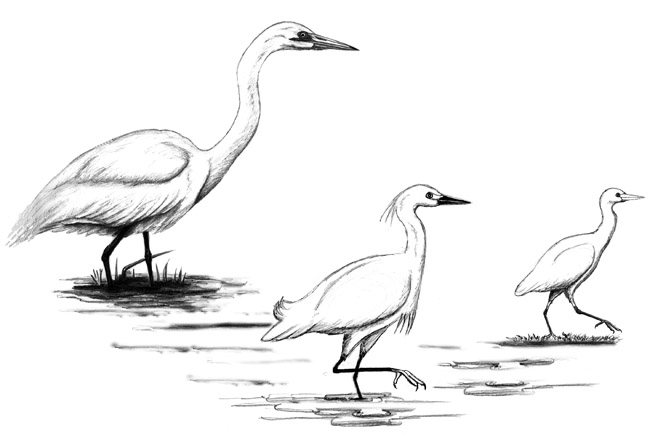
Dear Bird Folks,
A few years ago you told me Great Blue Herons don’t breed on the Cape, which is why we see fewer of them in the summer. What about those white egrets that I’ve been seeing everywhere? Will they also be heading out or do they nest here? I hope they stay because I like seeing them.
– Jake, Eastham, MA
I like them, too, Jake,
Nothing brightens up a marsh more than a flock of majestic white egrets. I also enjoy their relaxed personalities. They seem totally chill. Great Blue Herons, on the other hand, are more like ticking time bombs. Get within 800 feet of a great blue and it will explode into flight, giving off a horrific, croaking scream, as if a crab has just clamped down on one of its tonsils. Egrets aren’t nearly as edgy. The other reason why I like egrets is their color. Their total whiteness makes me feel that I’m not the palest creature strolling the Cape’s beaches and I appreciate it. Sometimes people ask me what the difference is between herons and egrets and the answer is nothing. Egrets are actually herons, but with a fancier name. The name “egret” comes from the French word “aigrette,” which refers to the gorgeous plumes the birds display during the breeding season. So, basically egrets are nothing more than tricked-out herons.
There are three species of egrets regularly seen on Cape Cod. There’s the very tall Great Egret, the much smaller Snowy Egret and the far less common Cattle Egret. I’m going to begin with the Great Egret since its local population has been increasing recently, so I might as well lead with a positive story.
I don’t know how old you are, Jake, but if you lived around here during the 1800s, you likely saw zero Great Egrets. For a whole host of reasons, including plume hunting, egrets were essentially nonexistent in these parts in the olden days. But eventually the stupid feather fad ended and the birds slowly found their way back to Massachusetts. In 1954, the first pair of egrets in forever nested in the town of Hanson, MA. Gradually other egrets followed and today Massachusetts boasts several hundred breeding pairs of these handsome birds. The bulk of the Cape’s Great Egret population breeds on Chatham’s Monomoy National Wildlife Refuge. This breeding area is not only important for the birds, but it is the last remaining property in Chatham without a white picket fence around it.
You are right when you said Great Blue Herons don’t breed around here and I’m not sure why. It could be the Cape just doesn’t have the right habitat the herons prefer and perhaps the birds are upset because none of the shopping centers offer “heron only parking.” Whatever the reason, it doesn’t bother the egrets one bit. They love it here. In addition to the Great Egrets, we also have the equally white, but smaller Snowy Egrets. When standing side-by-side, the difference between the two egrets is obvious. The Great Egret is about fifteen-inches taller (or roughly the height difference between Hugh Jackman and Tom Cruise). In addition to the size disparity, the two birds have other dissimilarities. The beak of the Great Egret is yellow, while the beak and legs of the adult Snowy Egret are black. It’s important to note that while the snowy’s legs are black, their feet are brilliant yellow. This is why many folks refer to Snowy Egrets as the birds with the “golden slippers,” but not me. I don’t understand the slipper thing. Birds don’t wear slippers. I prefer to think of them as the birds that enjoy stepping in mustard. I believe mine is a more delicious analogy.
The third Cape egret is the Cattle Egret. A few inches shorter than a snowy, the Cattle Egret doesn’t have a lot in common with the other two egrets, except for its white coloring and the same last name. Cattle Egrets are also the more interesting of the three birds. Instead of searching for tidal pools, Cattle Egrets look for pastures of cattle (hence their first name). But don’t get the idea that Cattle Egrets are interested in eating cows. These birds have no desire to consume beef. They are looking for the creatures the cows often kick up, namely insects…the other white meat.
The story of how Cattle Egrets found their way to Cape Cod is an adventure in itself. They didn’t arrive here via Westchester County, like so many Cape residents have; instead Cattle Egrets actually flew over from Africa. They first landed in South America in 1877 and slowly worked their way north, eventually arriving in Massachusetts in 1952. For years the local population of Cattle Egrets was on the increase, but then their numbers began to decline. Today Cattle Egrets are listed as rare visitors to Cape Cod. Why have they forsaken us? We aren’t 100% sure, but since these egrets originated from the scorching plains of Africa, it would be safe to assume that they found our cold, nasty springs too unpredictable for breeding. Yup, even African birds can’t handle New England’s weather.
Egrets are only on the Cape during the warmer months, Jake, so enjoy them while they are here. Just remember: If you see a tall white bird with a yellow bill, it’s a Great Egret. But if it’s rather short and has a black bill, then it’s a Snowy Egret. Just one word of caution: If a Snowy Egret is looking your way, be sure to hide the mustard. I’m not totally certain that they like to step in mustard, but why take a chance?